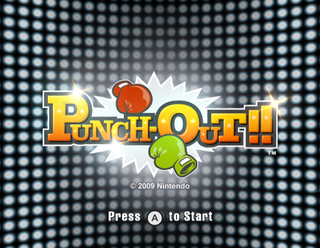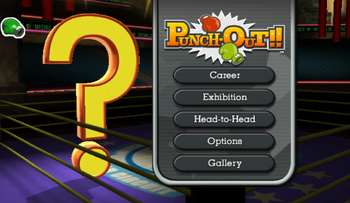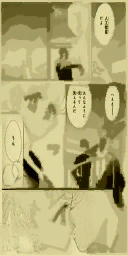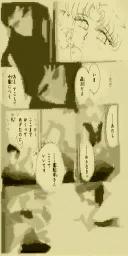Punch-Out!! (Wii)
| Punch-Out!! |
|---|
|
Developer: Next Level Games
|
To do:
|
After fifteen years, Punch-Out!! finally returned to stores, bringing the familiar boxers back into the ring once more. It also introduced an official two-player mode and a few internet memes.
Contents
Sub-Pages
| Notes |
Unused Content
Unused Fighter
The game references an unused fighter - JoeTemplate. When loaded into the game, he appears as unique otherwise unused model of what looks like an older version of Soda Popinski with slightly differing animations, but doesn't have a moveset defined and just stands still.
You can fight against him in the European version by using the code below (replaces Glass Joe):
CC330F00 476C6173 04330F00 4A6F6554 04330F04 656D706C 04330F08 61746500 04330F0C 4A6F6554 04330F10 656D706C 04330F14 61746500 04324F60 6172742F 04324F64 66652F6C 04324F68 6F616469 04324F6C 6E670000 04324F70 00000000 0431DFC0 54726169 0431DFC4 6E696E67 0431DFC8 2F747261 0431DFCC 696E696E 0431DFD0 675F7072 0431DFD4 655F6669 0431DFD8 67687400
Unused Fighter Data
If Giga Mac, Little Mac, and the H2H version of Little Mac are spawned as opponents in the single player mode, it is revealed they actually have a defined AI and fight back, though they will not get back up if they are knocked down.
Unused Transition
Found in the NIS/Transitions folder is a bundle of files called chocolate_transition_1. If another transition is replaced with it, the game shows a bunch of "Doc's Remedy" chocolate candy bars covering the screen and then disappearing.
Unused Graphics
Found in the characters folder is an unused question_mark model. This could've been used instead of the silhouettes in career mode, or as the character model for the random fighter in last stand.
Under the art/fe folder is a file called mc_banner.tpl, which features the GameCube banner image for Super Mario Strikers, another title developed by Next Level Games.
Unused Dialogue
Note that some of the following exerts can be heard in the game's sound boards, but are never used in normal gameplay.
Don Flamenco
Flamenco has an exert that goes entirely unused.
| Audio | Transcript | Translation and Comments |
|---|---|---|
| Qué mal. | "That's bad." A cue for an unknown attack. |
Several of Flamenco's lines were also re-recorded or re-worked.
| Unused | Used | Transcript for Unused Dialogue | Transcript for Used Dialogue | Translation and Comments |
|---|---|---|---|---|
| Olé. | ¡Olé! | The attack cue for Don Flamenco's left hook was going to have a bit more flourish to it. | ||
| ¿Quieres más, eh? ¿Quieres más? | ¿Qué pasa? ¿Quieres más? | "You want some more, huh? You want some more?" "What's wrong? You want some more?" Another taunt for when Little Mac has been knocked down. |
Super Macho Man
Macho Man also has some attack cues that go unused, some of which hint at moves that never made it into the final game.
| Audio | Transcript | Comments |
|---|---|---|
| Cover shot! | Perhaps an alternate cue for one of Macho Man's uppercuts. | |
| Curtain call! | A cue for an unknown attack. | |
| Psych, baby! | A cue for some sort of fake-out punch. Super Macho Man has unused fake-out animations (likely for his Title Defense fight, where fakeouts are commonly used by opponents) where this sound effect may have been used. | |
| Rats! | Would have been used for when an attack was missed. |
Doc Louis
Mac's trainer has some unused "tips" for the Great Tiger fight(s).
| Audio | Transcript |
|---|---|
| Hey, Mac baby! Make this cat purr! Tickle his belly with a Star Punch! | |
| Alright Mac, listen up! Great Tiger can do anything! Anything! |
Unused Music
An unused looping track. Like many of the game's tracks, it's loosely based on the main Punch-Out!! theme. Its purpose is unclear, but it sounds similar to the music used for the Wii Fit Tutorial.
Remasters of the tracks from the NES version of Punch-Out!! for starting a round, winning, losing, and getting a game over that doesn't come to use at any point. They sound as if they are related to the Minor Circuit, which is odd since circuits don't normally have these tracks; the character-themed music is used instead. In fact, there is no variations at all of the music for starting a round in the final game.
Localization Note
Found immediately after the copyright notice string ("All Rights, including the copyrights of Game, Scenario, Music and Program, reserved by NINTENDO.") in ukenglish.loc is a note for the game's localization teams:
Do not edit this. Only english is needed.
Obscured Graphics
To do:
|
Between rounds in Title Defense, Piston Hondo is shown reading a manga. While a few of the panels inside can be seen normally, most of them cannot. By either moving the camera (such as with Dolphin) or ripping the textures from the disc, it turns out the manga he's reading is Sailor Moon (albeit with the panels rearranged a bit compared to the source material).
This was changed to a generic manga in the Japanese version, likely due to the developers getting sued over using the artwork without permission.
Debugging Features
The game has a multitude of debugging switches, but they're disabled in the final release. To re-enable them, open the game's main.dol and search for "/General/Build Info". Change the first instance of this into "/User" (remember to null-terminate the string). This only works in the European version of the game.
You can now add the switches into the datetime.ini file in the game's ini folder. The format of the switches is as follows:
Switch name = value
The switches referenced by the executable:
- GDCDemo (true/false) - Enters the GDC Demo mode; game locks you into career mode and ends after the minor circuit.
- Smoke Test (true/false) - Prints a string on the screen that counts down time. After the time finishes, a string confirming the completion of the test is printed.
- Smoke Test Duration (eg. 100.0) - Sets the duration of the smoke test
- Soak Test (true/false) - The game will control Little Mac on its own during fights
- RunFESoakTest (true/false) - The game will control the in-game menus on its own
- FESoakProfileNumber (eg. 3) - Sets which save data profile is used during the FE Soak Test
- FESoakCornermanTime (eg. 100) - Sets how long the game spends in the cornerman sequences
- FESoakDeleteProfile (true/false) - If true, the FE Soak Test will first delete the selected profile.
- FESoakScript (exhibition/championship/headtohead) - Selects which soak test script to load.
- FESoakLosses (true/false) - If true, Soak Test will lose HP when hit, else will be invincible.
- FESoakScreenShots - Function unknown. Presumably meant to take in-game screenshots and write them somewhere?
- UnlockForExhibition - Function unknown.
- SkipFE (true/false) - Skips the title screen and starts a fight immediately.
- SkipFeRandomizeDefender (true/false) - If SkipFE is enabled, the started fight's opponent is randomized.
- SkipFeDefenderName - (e.g DonkeyKong, GlassJoe) Selects the opponent.
- SkipFENintendoLoop - Function unknown.
- SkipFeCircuit - Function unknown. Seems to crash after every fight
- SkipFeUseHeadgearAssist - If SkipFE is enabled, makes Little Mac use the headgear accessory
- SkipFeControls - Function unknown.
- SkipFeUseOldRing - Function unknown.
- CrowdMax(e.g 20) - Sets the maximum number of people in the crowd.
- RecordGamesToDisk(true/false) - Writes a play_rec.dat file to title\00000001\00000002\data, but the file seems too short to actually contain a whole game's replay data...
- draw_replay_bar - Function unknown.
- gpu fifo - Function unknown.
- DisablePunchTargeting - Function unknown.
- UseNetworkPacketRecorder - Function unknown.
- AIVersusAI(true/false) - Just like "soak test"?
- ExtremeMode(true/false) - Enables the extreme mode (which is used in the final game, but this method of accessing it isn't)
Debugging Files
Along with .debug files for every .data file in the game, there is also a debugeffects file which holds seemingly random textures, including a Mario Kart-esque banana:
Internal Name
Internally, the game is referred to as Hippo, a reference to the Minor Circuit Champion.
Oddities
- Disco Kid's files are internally labeled as kidquick, indicating that he was originally intended to be Kid Quick from the 1984 arcade game.
- In an interview with Time Extension, an anonymous member of the development team stated that, as they were being careful to avoid cultural stereotypes, "Previous characters like Kid Quick were cut due to their dated representation and instead replaced with more modern original characters like Disco Kid."
Regional Differences
- In the North American version, there is a chance that title defense Soda Popinski will stay down on the sixth knockdown, resulting in a knockout. However, this is not the case in the European version, meaning the player can only win by TKO or decision.
- In the Japanese version, Mac waits for the opponent to fall to the mat before backing up. In the North American and European versions, Mac immediately backs away once the opponent's health bar is down.
- Interestingly, in the Chinese Nvidia Shield TV version, every fighter has a unique icon. Even Mac and Giga Mac have them! However, the credits are from the English version, meaning that Doc Louis doesn't get a unique icon.
- Some characters have different audio played in different cutscenes. Such as Mr. Sandman in his pre-fight cutscene, Piston Hondo in his TKO/KO animation, and contender Mr. Sandman's victory cutscene.
- The rotating stars present in the post-fight stats screen of the North American and European versions of the game are not present in the Japanese version.
The Punch-Out!! series
| |
|---|---|
| NES | Mike Tyson's Punch-Out!! |
| SNES | Super Punch-Out!! |
| Wii | Punch-Out!! |
| Related Games | |
| GameCube | Fight Night Round 2 |
- Pages missing developer references
- Games developed by Next Level Games
- Pages missing publisher references
- Games published by Nintendo
- Wii games
- NVIDIA Shield games
- Pages missing date references
- Games released in 2009
- Games released in July
- Games released on July 23
- Games released in May
- Games released on May 18
- Games released on May 22
- Games released in August
- Games released on August 27
- Games with hidden development-related text
- Games with unused graphics
- Games with unused music
- Games with unused sounds
- Games with regional differences
- To do
- Punch-Out!! series
Cleanup > Pages missing date references
Cleanup > Pages missing developer references
Cleanup > Pages missing publisher references
Cleanup > To do
Games > Games by content > Games with hidden development-related text
Games > Games by content > Games with regional differences
Games > Games by content > Games with unused graphics
Games > Games by content > Games with unused music
Games > Games by content > Games with unused sounds
Games > Games by developer > Games developed by Nintendo > Games developed by Next Level Games
Games > Games by platform > Android games > NVIDIA Shield games
Games > Games by platform > Wii games
Games > Games by publisher > Games published by Nintendo
Games > Games by release date > Games released in 2009
Games > Games by release date > Games released in August
Games > Games by release date > Games released in August > Games released on August 27
Games > Games by release date > Games released in July
Games > Games by release date > Games released in July > Games released on July 23
Games > Games by release date > Games released in May
Games > Games by release date > Games released in May > Games released on May 18
Games > Games by release date > Games released in May > Games released on May 22
Games > Games by series > Punch-Out!! series




